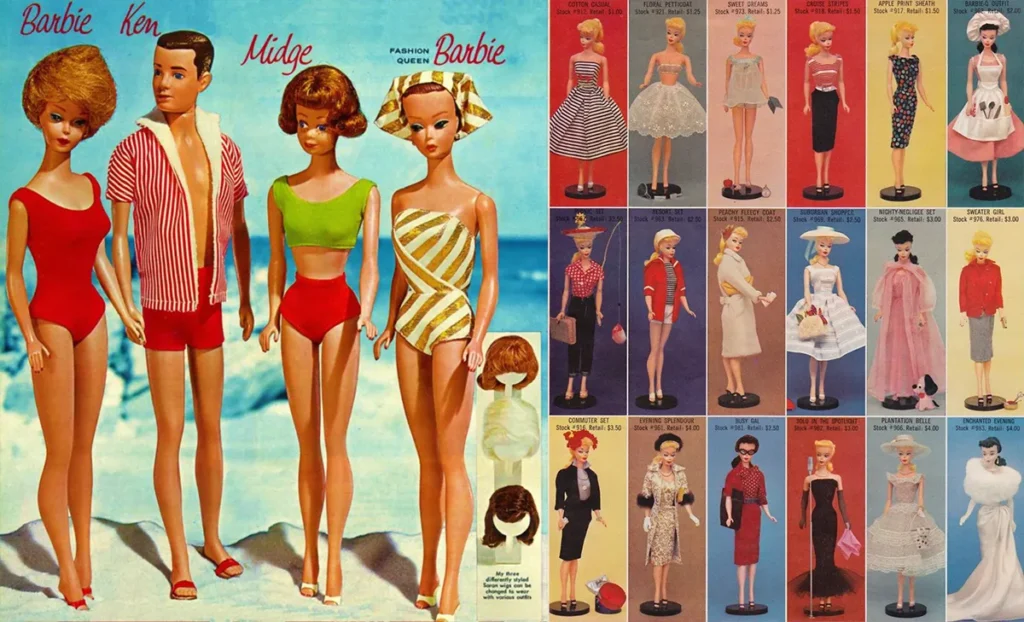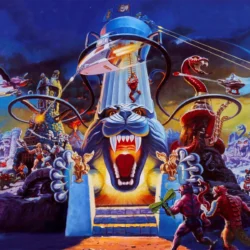The history of Barbie is not just the history of a toy. As a style icon, a symbol of empowerment and an emblem of inclusion, the doll has represented the evolution of female identity for over six decades. In this article we will trace the key moments of her life, showing how she embodies the changes of society over time.
Her name is Barbara Millicent Robert, but for all of us she is simply Barbie. Beloved by entire generations, she has inspired girls worldwide, becoming a cultural model. She has influenced fashion, cinema, and even politics, leaving a significant impact on popular culture. The History of Barbie tells us about the progress we have made and the work that still lies ahead.
Let’s go through it!
Contents
- When Was Barbie Created?
- Barbie’s Evolution in the 1960s
- Barbie and the Sexual Revolution in the 1970s
- Barbie and the Women Empowerment in the 1980s
- Barbie in the 1990s
- The 2000s, the Dark Ages in the History of Barbie
- Barbie Today
- Conclusions
When Was Barbie Created?
Barbie was born in 1959 from an idea by Ruth Handler, wife of Elliot Handler and co-founder of Mattel. Ruth noticed that her daughter Barbara had limited play options compared to her brother Kenneth. In fact, while Ken could become a cowboy, a soldier, or a firefighter, Barbara could only play as a mother or wife. The only other source of imagination were some two-dimensional dolls on which the little girl could attach paper clothes. Ruth noticed that Barbara used these dolls to invent careers and lifestyles. Hence the idea: why not give her a three-dimensional doll that could satisfy her creativity?
Actually, the idea was not entirely original. Ruth, in fact, drew inspiration from Bild Lilli, a German doll based on the character from an adult comic strip. Lilli was a rebellious woman by the standards of the time, but Ruth didn’t pay much attention to societal norms and decided to bring the toy to the United States.
The project was entrusted to Jack Ryan, who was then in charge of Mattel Research and Development department. Jack modified the original design with some significant improvements to the articulations, thus initiating what would become a revolution in the toy market.
The commercial strategy was exceptional. Barbie was marketed at a relatively low price, with a wide variety of optional clothes and accessories. Thanks also to massive advertising, the toy immediately became a huge success, selling 350,000 copies in the first year alone.
The Evolution of Barbie in the 1960s
In the 1960s, a whole world developed around Barbie. In fact, Mattel created the first Barbie house and new characters were born, such as Ken, Skipper, Francie, and Midge. Some of these new characters disappeared in the following years, leaving the place to more charismatic figures, such as Stacie, Shelly and Chelsea.
Furthermore, Barbie began to have her own personality. She bacame a model, a tennis player, a stylist, a teacher… She challenged the gender stereotypes, embracing the new ideals of emancipation of the time.
This evolution also affected her physical appearance. The silhouette changed to meet the tastes of the new generations. Softer features, long eyelashes, and a flexible waist made Barbie a true woman of her times.

Barbie and the Sexual Revolution in the 1970s
In the 1970s, freedom and beach life became an obsession for young Americans. This context inspired Barbie Malibu, an innovative doll featuring long blonde hair, a clean face, and tanned skin. However, the most revolutionary feature of this doll was her gaze. In fact, unlike traditional Barbies, Barbie Malibu looked straight into the eyes of her observer. An expression of awareness which made her a symbol of the sexual emancipation of those years.
Barbie Superstar was another iconic model of this period. With her new charming smile and the bent arm, the doll could pose just like a diva, embodying a new ideal of sexy and independent woman. The main source of inspiration came from the stars of the Disco Music and the Charlie’s Angels.
Barbie and the Women Empowerment in the 1980s
In the 1980s, the evolution of Barbie reflected the great changes taking place at Mattel. In fact, after Ruth and Elliot were accused of fraud and expelled from the Company, Judy Shackelford became the new marketing manager, infusing new life into the franchise. Judy insisted on the theme of women’s emancipation, bringing to life numerous new Barbies. As a doctor, astronaut, and sports Barbie engaged in fields traditionally dominated by men, thus contributing to the spread of a new feminine ideal.
Furthermore, Barbie became more inclusive, opening up to new ethnicities and cultures, as in the case of Black Barbie. This innovation allowed girls from traditionally excluded groups to feel more represented within society.
New aesthetic changes also appeared. In fact, the new “Mackie Face” gave Barbie a more sexy and provocative look. The new features attracted criticism from feminist groups, who accused Mattel of promoting an unrealistic idea of beauty. These attacks pushed the company to create, in 1989, California Dream Barbie, a doll with a more realistic and athletic physique.
The History of Barbie in the 1990s
The 1990s were full of ups and downs. Totally Hair Barbie was the most iconic model of the period, with her long blonde hair and trendy clothes. The model had a huge success and still remains one of the most iconic dolls in Barbie’s history. However, the franchise faced growing criticism from parents and feminists, who were concerned about the doll’s influence on young people. In particular, they highlighted negative effects on self-esteem. These attacks led to the creation of Share a Smile Becky in 1997. This Brand new Barbie in a wheelchair opened up representation for people with disabilities.
The 2000s, the Dark Ages in the History of Barbie
The beginning of the New Millennium was a difficult moment in the history of Barbie. Sales declined and the franchise was overwhelmed by the growing competition of new toys. In particular, Bratz dolls took a big slice of Barbie’s market share.
To cope with the crisis, Mattel introduced new dolls and accessories inspired by the themes of diversity and empowerment. However, these efforts did not reverse the trend.
Barbie Today
In recent years, Barbie has regained its popularity. The doll has successfully adapted to the continuous changes in the industry, leveraging the theme of inclusion. In particular, Barbie Fashionista has been a protagonist of this change, thanks to its ability to represent different social types. The motto “You Can Be Anything” has encouraged new generations to freely explore their potential.
Furthermore, thanks to new technologies, the franchise has been able to capture the interests of the new generations. Social media and online games, in fact, have projected Barbie into the digital world, inspiring new forms of entertainment.
Conclusions
From its birth to today, Barbie has been an icon of beauty and empowerment for girls worldwide. Over the years, she has played a crucial role in promoting diversity and personal fulfillment. From our perspective, we can look to the future with the hope of seeing how Barbie will continue to inspire future generations.









